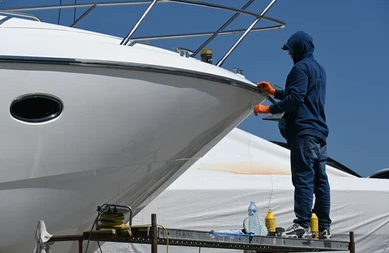Surface Refurbishment 101: Techniques, Benefits, and Applications
Surface refurbishment refers to the process of restoring and enhancing the surfaces of equipment, structures, or materials that have been worn, damaged, or degraded over time. This process is essential in maintaining the functionality, safety, and aesthetics of various assets across multiple industries, including oil and gas, marine, industrial, and residential sectors. Surface refurbishment can involve a range of techniques, from cleaning and coating to repairing cracks and polishing finishes.
This article will dive deep into the various surface maintenance solutions comprising the best techniques, their benefits and applications in enhancing and restoring surfaces.

Why Surface Refurbishment Matters
Surface refurbishment is a crucial practice for several reasons:
- Cost Savings: Refurbishing a surface is often more cost-effective than replacing entire components or structures. It reduces the need for new materials and extensive labour, resulting in significant savings.
- Extended Lifespan: Regular refurbishment can greatly extend the lifespan of equipment and structures. By addressing wear and tear before it becomes a major issue, refurbishment helps prevent the need for premature replacements.
- Enhanced Safety: In industries like oil and gas, where equipment failure can lead to catastrophic consequences, surface refurbishment ensures that critical surfaces remain in optimal condition, reducing the risk of accidents and enhancing overall safety.
- Compliance with Industry Standards: Many industries have strict regulations regarding the maintenance and safety of equipment and structures. Surface refurbishment helps companies stay compliant with these standards, avoiding fines and ensuring operational continuity.
Common Surface Refurbishment Techniques
1. Surface Cleaning
Surface cleaning is a fundamental step in the refurbishment process. It involves removing contaminants such as dirt, rust, grease, and old coatings from the surface to prepare it for further treatment. Proper cleaning ensures that subsequent refurbishment steps, like coating or polishing, adhere effectively to the surface, resulting in a more durable and long-lasting finish.
- Chemical Cleaning: This method uses chemicals to dissolve or loosen contaminants on the surface. It is particularly effective for removing oils, greases, and other stubborn residues.
- Abrasive Blasting: Also known as sandblasting, this technique involves blasting the surface with abrasive materials like sand, grit, or steel shot to remove rust, paint, and other coatings. It’s commonly used for heavy-duty cleaning in industrial applications.
2. Surface Coating and Recoating
Once the surface is cleaned, applying a protective coating is a critical next step. Coatings serve as a barrier between the surface and environmental factors such as moisture, chemicals, and UV radiation, which can cause deterioration over time.
Types of Coatings
- Epoxy Coatings: Known for their durability, chemical resistance, and strong adhesion properties, epoxy coatings are widely used in industrial and marine environments.
- Polyurethane Coatings: These coatings offer excellent resistance to abrasion and impact, making them ideal for surfaces that endure heavy wear and tear.
Application Techniques
- Spraying: A fast and efficient method for applying coatings evenly over large surfaces. It’s often used in industrial settings where time and coverage are critical.
- Brushing and Rolling: These techniques are more suited for smaller areas or intricate surfaces where precision is required.
Crack and Damage Repair Tips for Surfaces
Surface refurbishment often involves addressing physical damage, such as cracks, chips, or holes in the material. Repairing these defects is essential to restore the structural integrity and functionality of the surface. This process typically involves the use of specialized materials that bond well with the existing surface, ensuring a seamless repair.
- Identifying Cracks and Damages: Before repairs can begin, it’s crucial to thoroughly inspect the surface to identify all visible and hidden damages. Techniques such as dye penetrant inspection or ultrasonic testing can be used for this purpose, especially in critical applications like pipelines or pressure vessels.
- Repair Materials:
- Fillers and Sealants: These materials are used to fill small cracks and gaps. Epoxy fillers, in particular, are popular due to their excellent bonding strength and resistance to environmental factors.
- Epoxy Resins: For larger cracks or structural repairs, epoxy resins provide a durable solution. They are highly effective in bonding materials and can be used in combination with reinforcement fibers for added strength.
- Application Process: After selecting the appropriate repair material, it is applied to the damaged area, carefully shaped, and then cured. The curing process is critical, as it ensures that the material hardens properly and bonds with the surface.
Surface Polishing and Finishing
The final step in surface refurbishment often involves polishing and finishing the surface to achieve the desired texture and appearance. This step not only enhances the aesthetics of the surface but also improves its functionality by reducing friction, preventing wear, and making it easier to clean.
- Polishing Techniques:
- Mechanical Polishing: This involves using abrasive materials or tools to gradually smooth the surface. It’s commonly used on metals and hard surfaces to achieve a mirror-like finish.
- Chemical Polishing: A process where chemicals are applied to smooth out microscopic imperfections. It’s often used for delicate surfaces that might be damaged by mechanical methods.
- Finishing Options:
- Matte Finish: Provides a non-reflective surface that is resistant to fingerprints and smudges, ideal for surfaces that require a subtle appearance.
- Gloss Finish: Offers a high-shine, reflective surface that enhances the color and depth of the material, commonly used in decorative applications.
- Textured Finish: Adds a tactile element to the surface, improving grip and reducing slip hazards, especially in flooring applications.
Applications of Surface Refurbishment
Surface refurbishment plays a critical role across various industries, ensuring that surfaces remain functional, safe, and visually appealing. Here are some key applications:
1. Oil and Gas Industry
- Pipeline Maintenance: Refurbishment techniques like abrasive blasting and epoxy coating are essential for maintaining the integrity of pipelines, preventing corrosion, and extending their operational life.
- Offshore Platforms: Harsh marine environments can lead to rapid degradation of surfaces on offshore platforms. Surface refurbishment helps protect these structures from corrosion and mechanical damage, ensuring safety and longevity.
2. Marine Industry
- Ship Hulls: The constant exposure to seawater and marine organisms can cause significant wear and tear on ship hulls. Refurbishment through cleaning, coating, and polishing ensures these vessels remain seaworthy and efficient.
- Docking Facilities: Docks and other marine structures require regular surface refurbishment to withstand the corrosive effects of saltwater and constant physical impact.
3. Industrial Facilities
- Machinery and Equipment: In industrial settings, machinery and equipment are subject to heavy use and harsh conditions. Regular surface refurbishment, including cleaning, coating, and repair, helps keep these assets in optimal working condition.
- Storage Tanks: Refurbishing the surfaces of storage tanks, especially those holding chemicals or hazardous materials, is crucial for preventing leaks and ensuring safety compliance.
4. Residential and Commercial Buildings
- Flooring: High-traffic areas like commercial lobbies or residential hallways benefit from regular refurbishment, including polishing and recoating, to maintain their appearance and durability.
- Facade Refurbishment: The external surfaces of buildings, including walls and roofs, are constantly exposed to the elements. Refurbishment techniques like repainting, sealing, and polishing help preserve their structural integrity and aesthetic appeal.
Frequently Asked Questions (FAQs)
1. What is the typical lifespan of a refurbished surface?
- The lifespan of a refurbished surface depends on the materials used and the conditions it is exposed to. However, with proper maintenance, refurbished surfaces can last several years, often comparable to newly installed surfaces.
2. How often should surface refurbishment be performed?
- The frequency of surface refurbishment depends on the environment and usage. For instance, industrial surfaces exposed to chemicals or heavy wear may require annual refurbishment, while residential surfaces may only need attention every few years.
3. Can surface refurbishment be done on all materials?
- Most materials, including metals, concrete, wood, and composites, can be refurbished. However, the techniques and materials used will vary depending on the specific surface requirements.
4. Is surface refurbishment environmentally friendly?
- Yes, surface refurbishment is often more sustainable than replacement. It reduces waste and the need for new materials, and many modern coatings and cleaning agents are designed to be environmentally friendly.
5. What are the signs that a surface needs refurbishment?
- Common signs include visible wear, such as cracks, peeling paint, rust, and discoloration. Functional issues, like reduced performance or safety hazards, also indicate the need for refurbishment.
Related Article
Choosing the Right Surface Refurbishment Method for Your Needs
Factors to Consider When Selecting a Professional Surface Coating Contractor
Protective and Marine coatings solutions in Nigeria
Conclusion
At Epoxy Oilserv Nigeria Limited, we specialize in top-notch surface refurbishment services tailored to meet the unique needs of various industries. Our expert team is equipped with the latest techniques and high-quality materials to restore and protect your assets, ensuring they remain in peak condition.For more information or to schedule a consultation, visit us at Epoxy Oilserv Nigeria Limited and discover how we can help you extend the life of your surfaces while saving on costs and enhancing safety.

